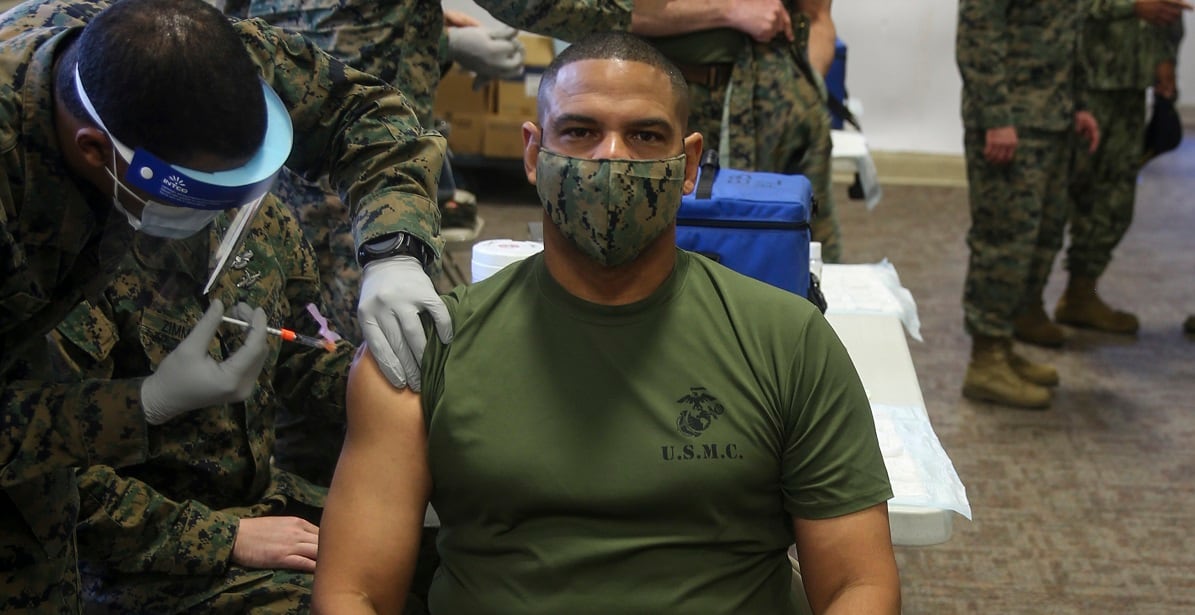Until recently, the Defense Department had been reporting that no fully vaccinated service members had died of COVID-19 complications, though two had been partially vaccinated when they contracted the novel coronavirus.
Without identifying the individual, a spokesman told Military Times on Wednesday that one breakthrough case has proved fatal.
“A recent review of COVID-19 deaths has shown that a fully vaccinated service member has died from COVID-19,” Army Maj. Charlie Dietz said. “The department still finds the vaccines to be highly effective in protecting against COVID-19, and we continue to encourage service members to get the vaccine, as well as the booster shot, according to the CDC’s recommended timeline.”
The service member had received the one-dose Johnson & Johnson vaccine, which has shown lower immunity in some recipients when compared to the two-dose Pfizer or Moderna vaccines.
The most recent reported deaths include:
- Army Reserve 1st. Lt. Jason W. Hitch, 45, of the 993rd Transportation Company, 143rd Sustainment Command in Palatka, Florida, died Dec. 14.
- Navy Lt. Ivey Quintana-Martinez, 35, of Navy Reserve Center San Diego, died Dec. 18.
While breakthrough cases continue to make up a small minority of new COVID-19 infections, the highly contagious omicron variant has proven more likely to infect, but not necessarily cause major illness.
And while November saw a short, two-week lull in service member COVID-19 deaths, following three months of double-digit deaths, December has seen a steady increase as the omicron variant begins to break records for new cases around the U.S.
The last half of 2021 has been by far the deadliest for the military. As of Wednesday, 82 service members have died of COVID-19 complications, 65 of those since July. Previously, the services had generally been reporting one or two deaths a month since the start of the pandemic.
Along with the rest of the country, the military is seeing an uptick in cases, with more than 261,000 reported to date. The mortality rate among troops, 0.03%, continues to be much lower than the 1.6% nationwide.
At the same time, the services’ vaccine deadlines are passing: The remaining components are the Navy and Marine Corps reserves, on Dec. 28; the Air National Guard, which just extended its deadline to be fully vaccinated to Dec. 31 (from Dec. 2); and the Army Reserve and National Guard, who have until June 30.
RELATED

To date, 1,597,631 troops are fully vaccinated ― just under 70% ― and another 332,263, or 14%, have had the first of a two-dose regimen.
As deadlines pass, the services are beginning to involuntarily separate troops who have refused to be vaccinated or have not received a waiver. To date, no religious exemptions have been granted.
The active duty Army, after reaching 98% full or partial vaccination on their Dec. 15 deadline, is set to begin discharges in January. In the meantime, two battalion commanders, and four others in a leadership role, have been relieved of their positions. The Army has said about 3,800 soldiers are continuing to decline vaccination, while more than 6,000 have received temporary exemptions for administrative or medical reasons.
The Air Force, which passed its active duty deadline on Dec. 2, has discharged at least 27 airmen for refusing to get vaccinated. According to the Air Force, about 1,000 active airmen had declined vaccination, with another 4,700 waiting for adjudication of their religious exemption requests. The latest data shows about 11,000 who are completely unvaccinated.
More than 100 active duty Marines have been involuntarily separated so far. Roughly 95% of the Corps is at least partially vaccinated, with about 9,000 having declined the vaccine, 1,007 of whom have received either an administrative or medical waiver.
The Navy’s most recent numbers show just under 5,500 active duty sailors unvaccinated, about 1.6% of the force. The service expects to complete the majority of its involuntary separations by June.
Meghann Myers is the Pentagon bureau chief at Military Times. She covers operations, policy, personnel, leadership and other issues affecting service members.




